or Broach (from the Fr. broche, originally an awl or bodkin; a spit is sometimes called a broach, and hence the phrase "to broach a barrel"; see Broker), a term now used to denote a clasp or fastener for the dress, provided with a pin, having a hinge or spring at one end, and a catch or loop at the other.
Brooches of the safety-pin type (fibulae) were extensively used in antiquity, but only within definite limits of time and place. They seem to have been unknown to the Egyptians, and to the oriental nations untouched by Greek influence. In lands adjacent to Greece, they do not occur in Crete or at Hissarlik. The place of origin cannot as yet be exactly determined, but it would seem to have been in central Europe, towards the close of the Bronze Age, somewhat before 1000 B.C. The earliest form is little more than a pin, bent round for security, with the point caught against the head. One such actual pin has been found. In its next simplest form, very similar to that of the modern safety-pin (in which the coiled spring forces the point against the catch), it occurs in the lower city of Mycenae, and in late deposits of the Mycenaean Age, such as at Enkomi in Cyprus. It occurs also (though rarely) in the "terramare" deposits of the Po valley, in the Swiss lake-dwellings of the later Bronze Age, in central Italy, in Hungary and in Bosnia. (fig. 1).1

From the comparatively simple initial form, the fibula developed in different lines of descent, into different shapes, varying according to the structural feature which was emphasized. On account of the number of local variations, the subject is extremely complex, but the main lines of development were approximately as follows.
Towards the end of the Bronze Age the safety-pin was arched into a bow, so as to include a greater amount of stuff in its compass.
In the older Iron Age or "Hallstatt period" the bow and its accessories are thickened and modified in various directions, so as to give greater rigidity, and prominences or surfaces for decoration. The chief types have been conveniently classed by [v.04 p.0642]Montelius in four main groups, according to the characteristic forms:—
I. The wire of the catch-plate is hammered into a flat disk, on which the pin rests (fig. 2)
Fig. 2.—Type I. with disk for catch-plate.

II. The bow is thickened towards the middle, so as to assume the "leech" shape, or it is hollowed out underneath, into the "boat" form. The catch-plate is only slightly turned up, but it becomes elongated, in order to mask the end of a long pin (fig. 3).
III. The catch-plate is flattened out as in group I., but additional convolutions are added to the bow (fig. 4).
IV. The bow is convoluted (but the convolutions are sometimes represented by knobs); the catch-plate develops as in group II. (fig. 5). For further examples of the four types, see Antiquities of Early Iron Age in British Museum, p. 32.
Among the special variations of the early form, mention should be made of the fibulae of the geometric age of Greece, with an exaggerated development of the vertical portion of the catch-plate (fig. 6).
Fig. 3.—Type II. with turned-up and elongated catch-plate. a, "Leech" fibula; b, "Boat" fibula; c. variation of "Boat" fibula.

The example shown in fig. 7 is an ornate development of type II. above.
In the later Iron Age (or early La Tène period) the prolongation of the catch-plate described in the second and fourth groups above has a terminal knob ornament, which is reflexed upwards, at first slightly (fig. 8), and then to a marked extent, turning back towards the bow.
A far-reaching change in the design was at the same time brought about by a simple improvement in principle, apparently introduced within the area of the La Tène culture. Instead of a unilateral spring—that is, of one coiled on one side only of the bow as commonly in the modern safety-pin—the brooch became bilateral. The spring was coiled on one side of the axis of the bow, and thence the wire was taken to the other side of the axis, and again coiled in a corresponding manner before starting in a straight line to form the pin. Once invented, the bilateral spring became almost universal, and its introduction serves to divide the whole mass of ancient fibulae into an older and a younger group.
Fig. 4.—Type III with disk for catch-plate, and convoluted bow.
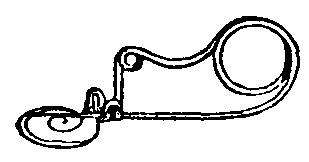
With the progress of the La Tène period (300-1 B.C.) the reflection of the catch-plate terminal became yet more marked, until it became practically merged in the bow (fig. 9). Meanwhile, the bilateral spring described above was developing into two marked projections on each side of the axis. In order to give the double spring strength and protection it was given a metal core, and a containing tube. When the core had been provided the pin was no longer necessarily a continuation of the bow, and it became in fact a separate member, as in a modern brooch of a non-safety-pin type, and was no longer actuated by its own spring.
The T-shaped or "cross-bow" fibula was thus developed. During the first centuries of the Empire it attained great size and importance (figs. 10-12). The form is conveniently dated at its highest development by its occurrence on the ivory diptych of Stilicho at Monza (c. A.D. 400).
In the tombs of the Frankish and kindred Teutonic tribes between the 5th and 9th centuries the crossbar of the T becomes a yet more elaborately decorated semicircle, often surrounded by radial knobs and a chased surface. The base of the shaft is flattened out, and is no less ornate (fig. 13). At the beginning of this period the fibula of King Childeric (A.D. 481) has a singularly complicated pin-fastening.
Fig. 7.—Gold fibula from Naples.
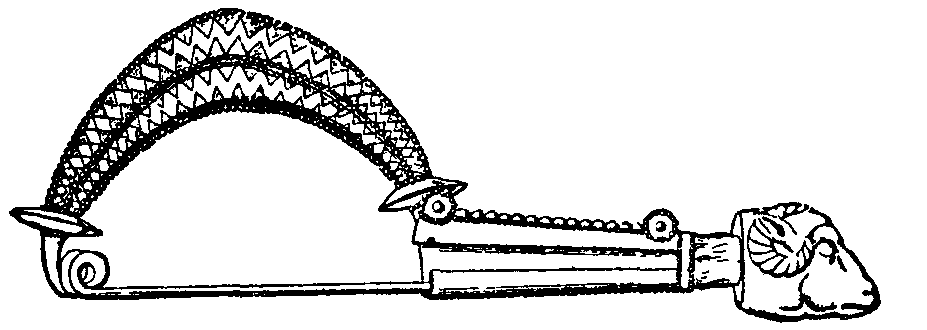
Fig. 6.—Greek geometric fibula.

Fig. 5.—Type IV. with turned-up catch-plate and convoluted bow.

Fig. 8.—Early La Tène period. Reflexed terminal ornament.
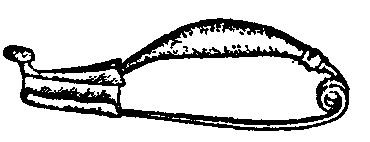
So far we have traced the history of the safety-pin form of brooch. Concurrently with it, other forms of brooch were developed in which the safety-pin principle is either absent or effectually disguised. One such form is that of the circular medallion brooch. It is found in Etruscan deposits of a fully developed style, and is commonly represented in Greek and Roman sculptures as a stud to fasten the cloak on the shoulder. In the Roman provinces the circular brooches are very numerous, and are frequently decorated with inlaid stone, paste or enamel. Another kind of brooch, also known from early times, is in the form of an animal. In the early types the animal is a decorative appendage, but in later examples it forms the body of the brooch, to which a pin like the modern brooch-pin is attached underneath. Both of these shapes, namely the medallion and the animal form, are found in Frankish cemeteries, together with the later variations of the T-shaped brooch described above. Such brooches were made in gold, silver or bronze, adorned with precious stones, filigree work, or enamel; but whatever the richness of the material, the pin was nearly always of iron. The Scandinavian or northern group of T-shaped brooches are in their early forms indistinguishable from those of the Frankish tombs, but as time went on they became more massive, and richly decorated with intricate devices (perhaps brought in by Irish missionary influence), into which animal forms were introduced. The period covered is from the 5th to the 8th centuries.
Fig. 9, a-d.—Fibula of the La Tène period, showing the development of the reflexed terminal, and the bilateral spring.

Fig. 11.—Fibula with niello work. 3rd century A.D.

Fig. 10.—Military Fibula. 3rd century A.D.

The T-form, the medallion-form, and (occasionally) the animal forms occur in Anglo-Saxon graves in England. In Kent the medallion-form predominates. The Anglo-Saxon brooches [v.04 p.0643]were exquisite works of art, ingeniously and tastefully constructed. They are often of gold, with a central boss, exquisitely decorated, the flat part of the brooch being a mosaic of turquoises, garnets on gold foil, mother of pearl, &c. arranged in geometric patterns, and the gold work enriched with filigree or decorated with dragonesque engravings.
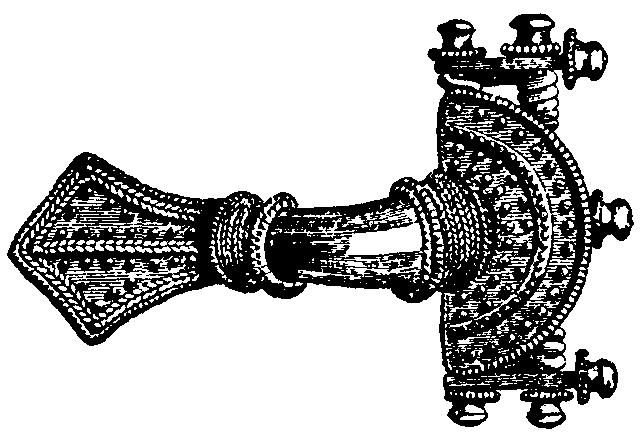
The Scandinavian brooches of the Viking period (A.D. 800-1050) were oval and convex, somewhat in the form of a tortoise. In their earliest form they occur in the form of a frog-like animal, itself developed from the previous Teutonic T-shaped type. With the introduction of the intricate system of ornament described above, the frog-like animal is gradually superseded by purely decorative lines. The convex bowls are then worked à jour with a perforated upper shell of chased work over an under shell of impure bronze, gilt on the convex side. These outer cases are at last decorated with open crown-like ornament and massive projecting bosses. The geographical distribution of these peculiar brooches indicates the extent of the conquests of the Northmen. They occur in northern Scotland, England, Ireland, Iceland, Normandy and Livonia.
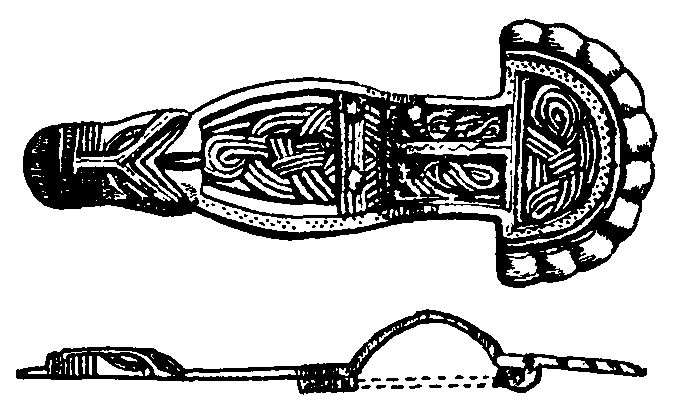
The Celtic group is characterized by the penannular form of the ring of the brooch and the greater length of the pin. The penannular ring, inserted through a hole at the head of the long pin, could be partially turned when the pin had been thrust through the material in such a way that the brooch became in effect a buckle. These brooches are usually of bronze or silver, chased or engraved with intricate designs of interlaced or dragonesque work in the style of the illuminated Celtic manuscripts of the 7th, 8th and 9th centuries. The Hunterston brooch, which was found at Hawking Craig in Ayrshire, is a well-known example of this style. Silver brooches of immense size, some having pins 15 in. in length, and the penannular ring of the brooch terminating in large knobs resembling thistle heads, are occasionally found in Viking hoards of this period, consisting of bullion, brooches and Cufic and Anglo-Saxon coins buried on Scottish soil. In medieval times the form of the brooch was usually a simple, flat circular disk, with open centre, the pin being equal in length to the diameter of the brooch. They were often inscribed with religious and talismanic formulae. The Highland brooches were commonly of this form, but the disk was broader, and the central opening smaller in proportion to the size of the brooch. They were ornamented in the style so common on Highland powder-horns, with engraved patterns of interlacing work and foliage, arranged in geometrical spaces, and sometimes mingled with figures of animals.
(A. H. Sm.)